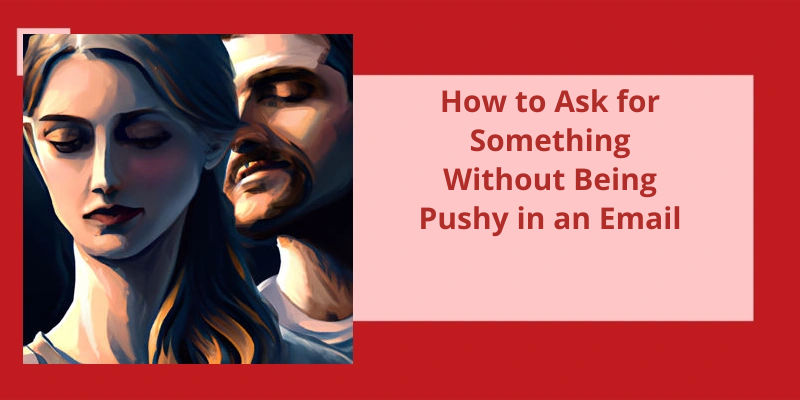Effective communication in today's fast-paced digital world can be a challenge for many of us. Whether you're writing an email to a colleague, a superior, or a potential client, the way you frame your message can make all the difference. One issue that many people struggle with is how to ask for something without coming across as pushy or abrupt. To be successful, it's essential to strike a balance between being direct and being polite. This means finding a way to make your request stand out, while also respecting the other person's time and schedule. In this article, we'll explore some tips and strategies for how to ask for something without being pushy over email, so you can make the most of your communication skills and achieve your desired outcome.
How Do You Ask Without Demanding?
Asking for what you want can be a tricky endeavor. Aiming to get what you want without coming off as demanding or pushy can feel like a delicate balance. However, you can master the art of asking without demanding by employing a few key tactics.
One of the most important strategies is to ask with commitment. This means taking the time to question whether what you want is truly aligned with your values and goals. When you ask from a place of genuine curiosity and passion, it helps to convey your sincerity and authenticity.
Along with commitment, asking with awareness is crucial. Every request comes with a price – whether it’s time, money, or effort. Being mindful of the impact your request may have on the other person will help you frame it in a way that’s respectful and considerate.
Another key element is asking without fear. It’s natural to worry about rejection or getting a negative response, but letting fear control your approach can undermine your effectiveness. Instead, try to approach the situation with confidence and trust in yourself.
Building trust is another vital aspect of asking without demanding. Demonstrating reliability and accountability can help to establish a foundation of trust in your relationships. When you ask for something, people will be more likely to take you seriously if they trust that you’re sincere and that your intentions are good.
Finally, it’s important to ask without expectations. While it’s natural to hope for a positive outcome, getting too attached to a specific result can come across as needy or entitled. Instead, focus on being open and flexible, and be willing to accept whatever response you receive with grace and gratitude. By adopting these approaches to asking for what you want, you can increase the chances of getting what you desire while maintaining healthy and respectful relationships with those around you.
Now that we’ve gone over some tips for writing a follow-up email after receiving no response, it’s important to keep in mind that there are additional factors to consider. The tone, structure, and timing of your follow-up can all impact the success of your outreach. With that in mind, let’s take a closer look at some best practices for crafting a polite and effective follow-up message.
How Do You Follow Up an Email After No Response Politely?
Following up an email after no response can be challenging. It’s important to be patient and tactful while still conveying your message effectively. If you don’t hear back from someone, the first step is to avoid sending follow-up emails too quickly. Give the recipient some time to review your initial message and respond if they havent already. It’s important not to be pushy or demanding, as this can be off-putting and may even lead to further delays.
Consider whether your first email included a clear ask or call to action. If not, you could be leaving the recipient unsure of how to respond. In your follow-up, be sure to restate your request and provide any relevant details or context. This will make it easier for the recipient to understand what youre asking for and respond accordingly.
While it can be tempting to simply resend your first email in it’s entirety, this is rarely an effective follow-up strategy. If someone didnt respond to your initial message, theyre unlikely to do so after receiving the exact same message again. Instead, consider adjusting your approach in your follow-up message. This might mean providing additional information, making a stronger case for why your request is important, or simply tweaking your tone to be more engaging.
Your subject line can also play an important role in whether your email is opened and responded to. Avoid generic or vague subject lines and opt for something more specific and relevant to your message. For example, “Checking in on our meeting request” is more likely to catch someones attention than “Following up.”. Be truthful in your subject line, and make sure it accurately reflects the content of your message. This will help build trust with the recipient and encourage them to engage with your email.
Finally, it can be helpful to include a brief reminder of your last touchpoint in your follow-up message. This might mean referencing a previous conversation or email exchange, providing context for why youre reaching out again. This can help jog the recipients memory and make it easier for them to respond quickly and effectively. Remember to be polite and professional throughout your follow-up message, even if youre feeling frustrated by the lack of response. By staying patient, persistent, and professional, youre more likely to get the response youre looking for.
The Importance of Personalization in Follow-Up Emails
Personalization is crucial in follow-up emails, as it establishes a connection between the sender and the recipient. By addressing the recipient by name and referencing specific details from previous interactions, the email becomes more relevant and engaging. Personalized follow-up emails are more likely to be opened and responded to, leading to increased success in sales, marketing, and customer service communications.
Source: How to Send a Follow-Up Email After No Response [+ 11 …
Now that we’ve discussed some tips on how to follow up without being annoying, it’s important to remember that effective communication is a crucial aspect of business success. Whether you’re following up after a job interview, sales pitch, or meeting, it’s important to strike the right balance between being persistent and pushy. With these strategies in mind, you can stay top of mind without alienating your contacts or appearing overly aggressive. So let’s delve deeper into the best practices for following up in a way that both builds rapport and advances your goals.
How Do You Follow Up Without Being Too Pushy?
Following up is an important part of any professional or personal relationship, but it can be a delicate balance between staying top of mind and being too aggressive. One key strategy for successful follow-up is to stay positive in your communication. If you come across as demanding or negative, it’s likely that your recipient will be turned off and less likely to respond. It’s important to remember that everyone is busy, and your message is just one of many that they’re receiving. By keeping your tone upbeat and friendly, youll make it easier for them to engage with you and keep the conversation going.
Another tip for effective follow-up is to keep your reminders short and to the point. Instead of sending lengthy emails, try to keep your communication concise and focused on the most important details. You might also consider using visuals or videos to help convey your message in a more engaging way. By keeping your messages short and sweet, youll be more likely to get a response without coming across as pushy.
Of course, it’s also important to be persistent in your follow-up efforts. Dont give up on your communication after just one attempt, especially if you feel like theres a good reason to stay in touch. But at the same time, you don’t want to be too aggressive or pushy in your approach. It’s essential to strike a balance between persistence and professionalism so that your recipient doesn’t feel like theyre being harassed or bombarded with messages.
Timing is another crucial factor to consider when it comes to follow-up. Depending on the nature of your relationship or communication, the best time to reach out may vary. For example, if youre trying to connect with someone in regards to a business opportunity, you might find that the best time is after business hours. On the other hand, if youre trying to connect with someone on a personal level, it might be best to reach out during the day when they’re more likely to be available. By considering the timing of your follow-up, youll be able to optimize your chances of success.
Finally, it’s essential to remember the details when youre following up with someone. This might mean referencing a previous conversation or reminding them of something you discussed in the past. By showing that you’ve been paying attention and taking notes, youll help to keep the conversation going and build trust with your communication partner. by staying positive, sending short reminders, not giving up, knowing the best time, and remembering the details, youll be able to follow up effectively without being too pushy.
Using Different Modes of Communication for Follow-Up (e.g., Email, Phone, Social Media)
- Send a follow-up email within 24 hours of initial communication.
- Make a phone call to follow up within a few days.
- Connect via social media to thank the person for their time and remind them of next steps.
- Use video conferencing to continue the conversation and build a stronger connection.
- Send a handwritten note to show appreciation for the opportunity and express interest in future collaboration.
- Follow up periodically to maintain the relationship and stay top of mind.
Conclusion
In conclusion, asking for something in an email can often feel like a delicate balancing act. It's important to be clear about what you're asking for while also being respectful of the recipient's time and priorities. By putting your ask at the top of the email and being concise in your language, you can increase the chances of getting the response you're looking for without coming across as pushy or rude. Remember, the key to a successful ask is to make sure it's easy to understand and quick to act upon. So, take the time to craft a thoughtful email and you'll be on your way to getting what you want.






